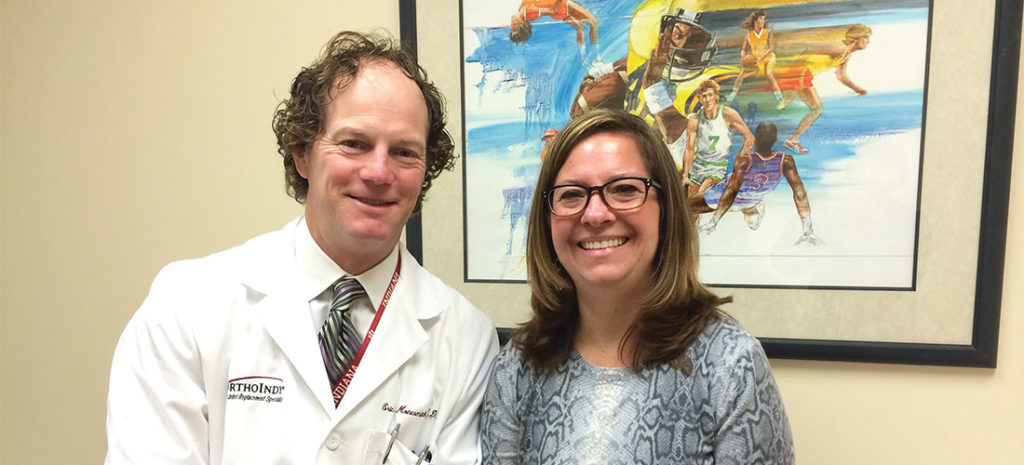This post is part of the Ultimate Guide to Total Hip Replacement
You feel a gentle tap on your shoulder and you follow the nurse back to the exam room. Although everyone is busily moving around, everything is quiet. You sit in silence and eagerly await to hear your diagnosis. Your physician comes in and you watch his mouth form words that explain what is wrong with you. But you can’t hear what he is saying. Quickly, your eyes shift to the lady standing beside him as she signs what your physician has just said.
Questions flood into your mind: What is the next step? How long will the recovery process take? When will you be pain-free again? You take a moment to gather yourself and slowly sign your first question. Again, you watch your physician respond and wait for your interpreter to sign you his responses. It’s a long process and it requires a lot of patience.
Spinal meningitis
This is a typical appointment for Monica Byrum. For as long as Monica can remember she has never been able to hear anything. She has always had to wait a moment to be told what everyone else hears immediately. At just 10 months old, she was diagnosed with spinal meningitis, which caused her to become deaf. Spinal meningitis is an infection of the fluid and membranes around the brain and spinal cord. Once infection starts, it can spread rapidly through the body.
However, Monica never let her lack of hearing frustrate her or get in the way of what she wanted to do in life. She was always determined to put herself out there and participate in activities other children were doing. Even as a child Monica participated in sports and various group activities.
Yet, at 12 years old, Monica hit another obstacle. She was diagnosed with Legg-Calve-Perthes disease, a childhood hip disorder initiated by disruption of blood flow to the ball of the femur. Due to this lack of blood flow, the bone dies and stops growing.
Over time, healing normally occurs. However, the main long-term problem with this condition is that it can produce permanent deformity of the femoral head, such as in Monica’s case. Because of this, Monica developed osteoarthritis very early and challenged her ability to stay competitive in sports.
In fact, Monica’s favorite hobby, cheerleading, became very painful. “I was a cheerleader in middle school, high school and college,” said Monica. “It was very painful with my disease, but I loved it. I told myself to never give up. I was always at the top of my stunts, smiling and jumping around to prove to everyone that I would never let my disease hold me back.”
Despite Monica’s determination, by the time she turned 23 years old, her hips barely allowed her to walk. Her family physician referred her to OrthoIndy and that’s when Monica met OrthoIndy hip surgeon, Dr. Eric Monesmith.
Physician examination- total hip replacement
Dr. Monesmith determined Monica needed both of her hips replaced. “The biggest risk when someone has a hip replacement at a very young age is that it will wear out during the patient’s lifetime,” said Dr. Monesmith. “However, revision surgery is possible and technology keeps improving. Modern hip replacement bearings have increased longevity.”
According to Dr. Monesmith the average age for a hip replacement is around 60 years old. However, anyone under 50 is considered very young for a hip replacement. Anyone in between 20 and 40 years old likely has a congenital, inflammatory or post-traumatic condition that has lead to arthritis, like Monica’s Legg-Calve-Perthes disease.
“If someone is in severe pain, with a significantly diminished quality of life from hip arthritis, even at such a young age, hip replacement can dramatically reduce pain and improve function,” said Dr. Monesmith. “This can restore quality of life, allow for more productive work and increased enjoyment of activities that were not possible or very painful before.”
In 1996, Monica decided that she wanted to be pain-free again and opted to have both her hips replaced by Dr. Monesmith.
“The best thing about my experience at OrthoIndy was the communication,” said Monica. “I am a deaf patient, but the staff never let that get in the way. My interpreter left for the day and the staff communicated with me on paper and Dr. Monesmith’s assistant, Kim, knew American Sign Language. Communication was never a barrier.”
For 14 years Monica was able to enjoy life, pain-free again. She was active and did not have to worry about her hips holding her back. Nonetheless, in February 2010 Monica had to visit Dr. Monesmith. Her left hip had started to bother her, common for patients who have a total joint replacement at such a young age.
“Monica’s plastic liner in her hip had worn significantly,” said Dr. Monesmith. “This plastic wear creates microscopic particulate debris, which the body responds to with an inflammatory cascade. This causes pain, bone loss and loosening of the components in the hip. In Monica’s case, fortunately, her bone loss was minimal and we were able to exchange the metal socket and put in a new liner.”
Hip revisions range from simple to extremely complex. Fortunately, techniques and technology continue to improve and revision surgery can be very successful. However, revisions typically involve longer surgical times and higher risks of complications compared to primary hip replacements.
After surgery
February 2014 she visited OrthoIndy again for her right hip revision. “After my first two surgeries I had a very quick recovery,” said Monica. “My fourth surgery has been more challenging. However, I am determined and take my time to be more patient every day. I attend physical therapy and notice that my hip improves daily.”
According to Dr. Monesmith, Monica has been the ideal patient. “Monica has been a great patient. She works hard and follows physicians’ advice. When both physician and patient work together, as we have, the outcomes can be excellent, even for very tough cases.”
Now Monica is able to take care of the flowers in her garden and walk again without a limp. Monica is most excited about getting back to her hula-hooping hobby.
To schedule an appointment with Dr. Monesmith please call 317.884.5166. or learn more about hip treatment options at OrthoIndy.

Schedule an appointment
Your well-being is important to us. Click the button below or call us to schedule an appointment with one of our orthopedic specialists. If your injury or condition is recent, you can walk right into one of our OrthoIndy Urgent Care locations for immediate care. For rehabilitation and physical therapy, no referral is needed to see one of our physical therapists.





